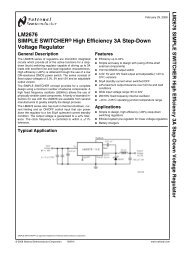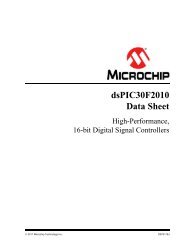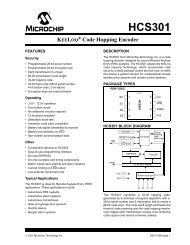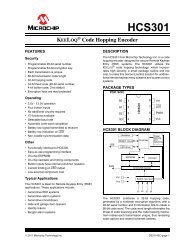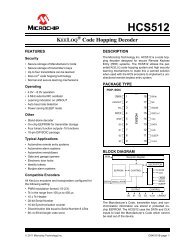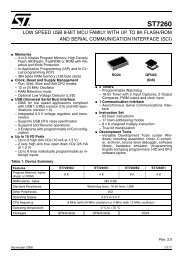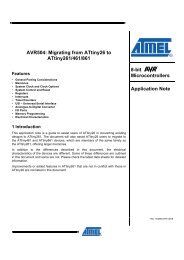You also want an ePaper? Increase the reach of your titles
YUMPU automatically turns print PDFs into web optimized ePapers that Google loves.
General-purpose timers<br />
<strong>STM32W108C8</strong><br />
filtered and not inverted.) The sequence of transitions of the two inputs is evaluated, and<br />
generates count pulses as well as the direction signal. Depending on the sequence, the<br />
counter counts up or down, and hardware modifies the TIM_DIR bit in the TIMx_CR1<br />
register accordingly. The TIM_DIR bit is calculated at each transition on any input (TI1 or<br />
TI2), whether the counter is counting on TI1 only, TI2 only, or both TI1 and TI2.<br />
Encoder interface mode acts simply as an external clock with direction selection. This<br />
means that the counter just counts continuously between 0 and the auto-reload value in the<br />
TIMx_ARR register (0 to TIMx_ARR or TIMx_ARR down to 0 depending on the direction),<br />
so TIMx_ARR must be configured before starting. In the same way, the capture, compare,<br />
prescaler, and trigger output features continue to work as normal.<br />
In this mode the counter is modified automatically following the speed and the direction of<br />
the incremental encoder, and therefore its contents always represent the encoder's position.<br />
The count direction corresponds to the rotation direction of the connected sensor. Table 85<br />
summarizes the possible combinations, assuming TI1 and TI2 do not switch at the same<br />
time.<br />
Table 85.<br />
Counting direction versus encoder signals<br />
Active<br />
edges<br />
Level on opposite<br />
signal (TI1FP1 for<br />
TI2, TI2FP2 for<br />
TI1)<br />
TI1FP1 signal<br />
TI2FP2 signal<br />
Rising Falling Rising Falling<br />
Counting on<br />
TI1 only<br />
Counting on<br />
TI2 only<br />
Counting on<br />
TI1 and TI2<br />
High Down Up No Count No Count<br />
Low Up Down No Count No Count<br />
High No Count No Count Up Down<br />
Low No Count No Count Down Up<br />
High Down Up Up Down<br />
Low Up Down Down Up<br />
An external incremental encoder can be connected directly to the MCU without external<br />
interface logic. However, comparators are normally used to convert an encoder's differential<br />
outputs to digital signals, and this greatly increases noise immunity. If a third encoder output<br />
indicates the mechanical zero (or index) position, it may be connected to an external<br />
interrupt input and can trigger a counter reset.<br />
Figure 37 gives an example of counter operation, showing count signal generation and<br />
direction control. It also shows how input jitter is compensated for when both inputs are used<br />
for counting. This might occur if the sensor is positioned near one of the switching points.<br />
This example assumes the following configuration:<br />
● TIM_CC1S = 01 (TIMx_CCMR1 register, IC1FP1 mapped on TI1).<br />
● TIM_CC2S = 01 (TIMx_CCMR2 register, IC2FP2 mapped on TI2).<br />
● TIM_CC1P = 0 (TIMx_CCER register, IC1FP1 non-inverted, IC1FP1 = TI1).<br />
● TIM_CC2P = 0 (TIMx_CCER register, IC2FP2 non-inverted, IC2FP2 = TI2).<br />
● TIM_SMS = 011 (TIMx_SMCR register, both inputs are active on both rising and falling<br />
edges).<br />
● TIM_CEN = 1 (TIMx_CR1 register, counter is enabled).<br />
131/215 Doc ID 018587 Rev 2





